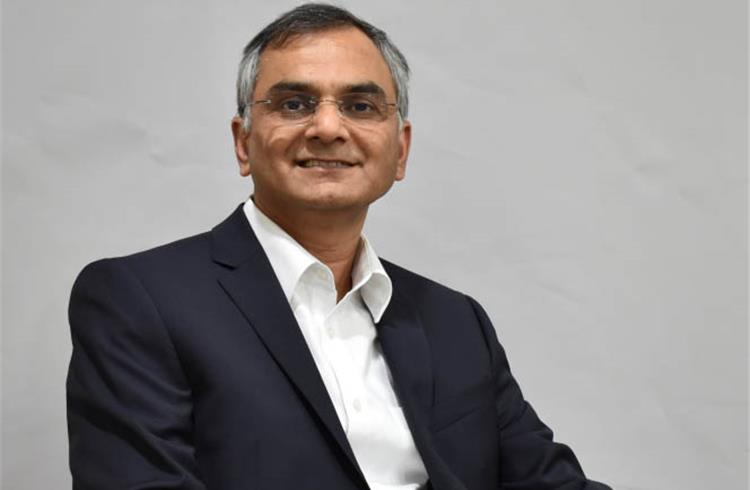'Whoever gets into e-mobility first takes maximum risk but also gets the maximum return.'
Naveen Gautam, Member of the Executive Board, Business Division - Electronics, Hella KgaA Hueck & Co, on the advance of electromobility and its impact on the automotive supplier fraternity.
Naveen Gautam, Member of the Executive Board, Business Division - Electronics, Hella KgaA Hueck & Co, and a recognised industry veteran, gives his perspective on the convergence of energy and automotive domains as electric mobility gains traction globally, new enabling technologies and their impact at the root level, awarding nature of risks involved in being the first mover in emerging business and how Hella India Automotive is prepping up for the future. Excerpts from the interview by Amit Panday:
How do you see the convergence of energy and automotive domains as electric mobility gains traction worldwide?
When we speak of electric mobility, it is understood that the (lithium ion) batteries will be there at the centre. If in India we are able to break through the battery cell manufacturing and assembly operations, it will revolutionise the industry.
So what will be the enabling technologies in future? I see solar energy cost (of panels) sharply declining. So anything on which you invest today where the costs are sharply declining, you will regret two years later. We might be on the verge of becoming the second cheapest location for producing solar power in the world. That will enable decentralised charging stations; so anyone can install a solar panel and start providing power to vehicles. You can create your own business. On the contrary, to set up a gas station, you need big political influence. So the decentralised power charging stations will become very frugal initiatives even in the rural India.
We will grow the industry that will complement electric mobility. Indigenous technologies around batteries, charging and motors will be areas we see growing. Three years will be a good testing time to see what results these areas generate.
The growth (e-mobility) will be retarded by the growth of infrastructure. This means that we anticipate 10 percent growth in the sales (of vehicles), then the roads must also grow by 10 percent or else the traffic will increase.
Typically suppliers in India wait to secure the business before making investments. OEMs, on the other hand, complain that there is no ecosystem for e-mobility in India, which clearly points at the supplier community not being ready to supply parts. What is your perspective on this?Somebody has to take risk. But it’s also true that the early bird gets the fruits. So whoever gets into this business first, they take maximum risk. But they also get the maximum return. This is the nature of business. Whether a Tier 1 supplier take risks and develops products for e-mobility for OEMs or whether the OEMs will pay Tier 1 suppliers in advance to develop products, this will be seen over the next two to three years.
My perspective is those who are big enough to take the risks, will benefit. What can Hella do? We are an old company but we have created a division, which works like a start-up, to focus on electric mobility (and two- and three-wheelers). We have a good plan and we give enabling freedom (to the two- and three-wheeler team), which is required to run an independent company within a company.
Do you think subsidies can play an important role in developing the ecosystem for electric mobility?
History says subsidies are good as long as it is for a limited period. To give a jump-start to anything, subsidy is good to get little volumes quickly. Beyond that, it is charity, which is neither scalable nor sustainable. Without these subsidies, a lot of electric rickshaws are getting sold, a lot of three-wheelers will also be sold.
The government can buy some fixed volumes or they can also create leasing option for the batteries or give subsidies. These are all different forms of giving a jump-start in the industry. It can provide support in the form of charging stations or even incentivise charging stations. However, historically, subsidies have been misused. So, I think, it has to be done for a limited time.
RELATED ARTICLES
BRANDED CONTENT: 'We aspire to be among the leading sensors and electro-mechanical products manufacturer'
P. Parthasarathy, Founder & Managing Director, Rotary Electronics Pvt Ltd shares the company's commitment and vision to ...
‘Big opportunity for startups lies in products in India’: Detlev Reicheneder
As electrification levels the playing field, the focus on tech and R&D to bring innovative products is the mantra for st...
'I hope my journey makes people say — I can do this too'
Ranjita Ravi, Co-founder of Orxa Energies — the maker of Mantis e-bikes — shares the challenges of building a startup an...





 16 Apr 2018
16 Apr 2018
 3873 Views
3873 Views





 Autocar Pro News Desk
Autocar Pro News Desk




